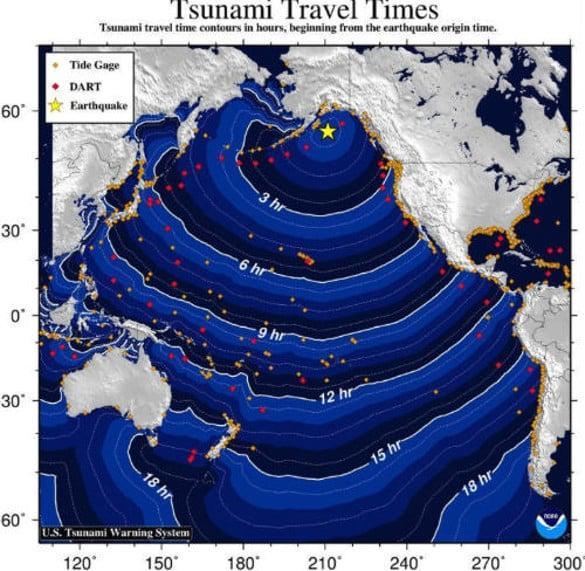 Courtesy/US National Tsunami Warning Center
Courtesy/US National Tsunami Warning CenterHSNW News:
A magnitude 7.9 earthquake, which struck 170 miles off the Alaska coast early Tuesday, led the Alaska government to issue a tsunami advisory — but the warning was lifted four hours later.
The USGS reported the magnitude 7.9 quake at 12:31 a.m. Alaska time. Officials had feared that tsunami waves could reach far inland, and issued tsunami guidance for the entire coastal area stretching from Alaska to the U.S. border with Mexico.
A magnitude 7.9 earthquake, which struck 170 miles off the Alaska coast early Tuesday, led the Alaska government to issue a tsunami advisory — but the warning was lifted four hours later.
“A tsunami was generated by this event, but no longer poses a threat,” a message from the United States National Tsunami Warning Center said minutes after 4 a.m. Alaska time.
The USGS reported the magnitude 7.9 quake at 12:31 a.m. Alaska time. CNN reports that officials had feared that tsunami waves could reach far inland, and issued tsunami guidance for the entire coastal area stretching from Alaska to the U.S. border with Mexico.
The National Tsunami Warning Center reported that a small tsunami wave — with height of less than eight inches — was observed in the Alaska towns of Old Harbor, Seward, and Kodiak.
The 8-inch wave was enough to activate the Tsunami sirens in Kodiak. “Evacuate inland or to higher ground above and beyond designated tsunami hazard zones or move to an upper floor of a multistory building depending on your situation,” the Alaska authorities warned on Tsunami.gov. “Move out of the water, off the beach, and away from harbors, marinas, breakwaters, bays and inlets.”
The police in Kodiak urged residents to seek higher grounds, and instructed people to go to the local high school or to the Safeway or Walmart parking lots.
The USGS warnings included San Francisco, where city authorities instructed people living within five blocks of the bay to prepare for evacuation.
The New York Times reports that geologists and residents of the West Coast have long been aware of the threat of “the big one.” A 2015 article in The New Yorker described, in terrifying detail, an expected megaquake in the Cascadia subduction zone, off the coast of the Pacific Northwest (see also: “The ‘Really Big One’: How a 9.0 Cascadia earthquake could play out,” HSNW, 26 October 2017; “In the Pacific Northwest, fear of the Big One should be channeled into pragmatic action,” HSNW, 14 August 2015; and “Preparing the Pacific Northwest for the Big One,” HSNW, 29 January 2015).
The Times notes that Tuesday’s quake came nearly seven years after Japan was rattled by a 9.0-magnitude earthquake, the strongest ever recorded there. The 11 March 2011 earthquake set off a powerful tsunami that breached the sea walls of coastal towns, killing at least 15,000 people, and sparking a major crisis at the Fukushima Daiichi Nuclear Power Station.
A 9.1-magnitude earthquake, one of the most powerful ever recorded, struck off the Indonesian island of Sumatra in December 2004, creating enormous waves that killed more than 230,000 people, mostly in Indonesia but also in India, Sri Lanka, Thailand, and as far away as Somalia.

